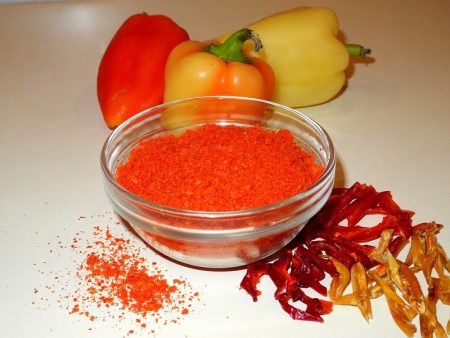
Paprika is a seasoning known and loved by many, made from red bell pepper. Paprika tastes sweet and very burning depending on the variety. It is added to various dishes and goodies, as it is a very useful product containing many vitamins and minerals. So it is safe to say that paprika not only makes dishes tastier, but also has a positive effect on the human body.
Paprika pepper was brought from Central America, but it also took root well in a colder climate, although it belongs to heat-loving plants. Therefore, planting and plant care require some specificity.
Content
Landing rules
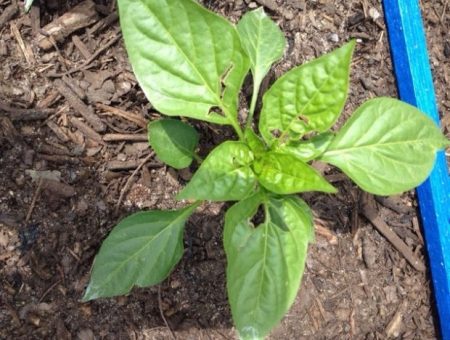
In the middle climatic zone, paprika is planted only in seedlings - that is, you must first grow seedlings from the seeds, and only then plant it on the garden bed. The only exception is the southern regions with a hot climate.
Seeds can be purchased in specialized stores, or collected by yourself.
Sowing is carried out in late February or early March. Wrap the seeds in a damp cloth and leave for several days so that they germinate. Sprouted seedlings in a weak solution of potassium permanganate for half an hour for disinfection. And at the final stage of preparation, it is advisable to hold the seeds in a growth stimulator for better germination. Now you can do the landing.
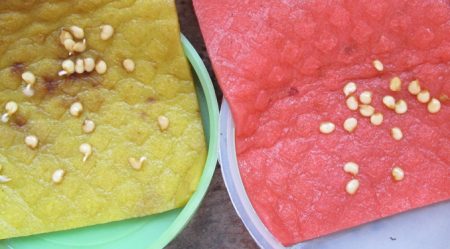
The soil for planting is prepared as follows: mix 2 parts of garden soil and peat and 1 part humus and sand. Mix all components and freeze well. Next, to enrich the soil, add wood ash at the rate of 1 glass per bucket of land. You can enrich the soil with a mixture of potash, nitrogen and phosphorus fertilizers: in this case, take 20 g of potash and nitrogen fertilizers and 40 g of phosphate.
Prepare plastic cups with fertile soil in advance (any other containers can be). In the soil, make a depression of 2 cm and lower a few grains. Fill with earth, slightly compact and pour water at room temperature. Cover the containers with transparent material (glass or film) and place in a warm, well-lit place. Covering material should be removed every day for some time for ventilation, and you also need to regularly moisten the ground. But you can’t overdo it with watering, since the sprouts can rot. When the sprouts hatch, the film or glass is removed at all.
When 2-3 leaves appear on the sprouts, it must be dived, that is, each sprout should be planted separately, so that the roots can receive all the necessary elements from the soil and develop normally. In prepared containers with fertile moist soil, sprouts are carefully transplanted along with clods of earth on the roots. Tamp the soil slightly, and water the seedlings.
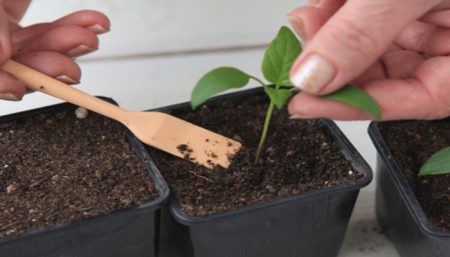
Now the sprouts should receive a sufficient amount of sunlight (at least 12 hours a day). We should not forget about regular watering. For 2 weeks according to the proposed planting on the seedling bed, tempering procedures will be useful - for this it is advisable to take the containers out to the street every day and leave them for several hours.
When the height of the seedlings reaches 20 cm, it can be safely planted in open ground.
To get a rich harvest of pepper, you need to choose a good place to grow it. Pepper does not like drafts, windy areas, direct sunlight and very hot air. Therefore, the place should be protected from the winds and be a bit in the shade.
The selected site must be prepared in the fall, dug up and fertilized. And before planting it needs to be loosened and saturated with potash and phosphorus fertilizers.
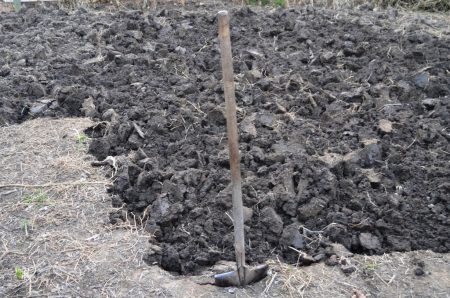
Pepper is transplanted in late May - early June. Prepare the holes in the soil at a distance of 35 cm from each other. The distance between the beds is about 45 cm. Seedlings are carefully removed with a lump of earth on the spine and transferred to the hole. The stem is buried to the first lower leaves, covered with soil and rammed. In the end, they must be watered with water at room temperature and long pegs are installed next to each bush, to which they will be tied in the future.
Care Rules
Further care for the bushes consists of watering, feeding, and the prevention of diseases and pests.
After planting on a bed, paprika is watered approximately once a week. For 1 bush, 1 liter of water is enough. The water temperature should be about 20 ° C, and after each irrigation, you need to loosen the earth around the stem so that the best aeration of the roots occurs and a crust does not form. In order to retain moisture in the soil, pepper bushes can be mulched with grass or straw.
Fertilizing the soil is carried out at least 3 times for the entire season.
For the normal growth and development of plants, nitrogen is required. Therefore, the first top dressing is carried out 2 weeks after transplanting plants to the bed with preparations containing nitrogen.
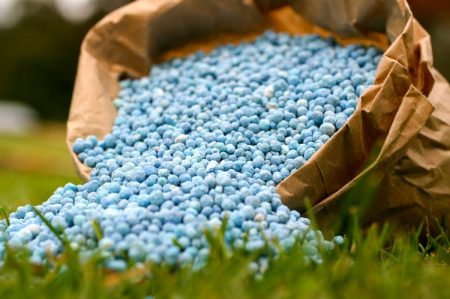
For the formation of full-fledged fruits, potassium is needed. Potash fertilizers are applied during the flowering period of pepper.
And the third top dressing is done during the formation of the first fruits. To do this, 2 teaspoons of potassium salt and superphosphate are dissolved in a bucket of water and the solution is watered around the bushes around the root.
Peppers are prone to invasion by common pests such as the bear, Colorado potato beetle, slugs, whiteflies and aphids. All pests can be collected manually, and plants are sprayed with a solution of wood ash against aphids.
The most common ailments of paprika are:
- falling of ovaries - will help to cope with the problem of a solution of boric acid (1 teaspoon per bucket of water),
- poor fruit development - can be cured with superphosphate or wood ash,
- yellowing of the leaves is the reason for the lack of nitrogen. Dissolve 1 teaspoon of urea in 10 liters of water and spray the bushes.
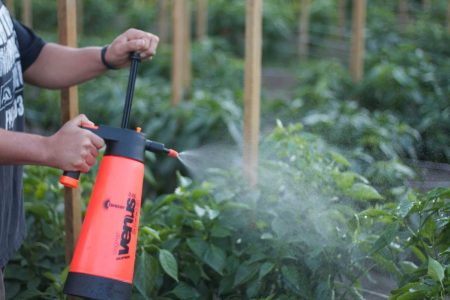
Harvested as the fruit ripens, but you can also remove slightly unripe paprika to remove excessive weight from the bush.
Paprika pepper: the best varieties
There are many varieties of paprika in the world, but I would like to dwell on some of the most common ones that have already been tested by Russian gardeners and have received wide appreciation. The ripening pepper can be early, mid-ripening and late ripening. The color of the fruits is also diverse, paprika can be purple, orange, red, yellow and green.
Big dad
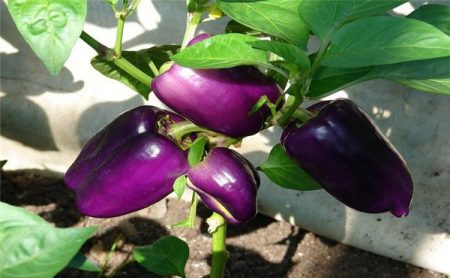
The variety belongs to the early ripe - from the bite of the sprouts to the collection of ripe fruits, it takes about 4 months. The bushes grow small - up to 75 cm tall and quite compact. This pepper can be grown in open and protected ground.
The leaves of the variety have a dark green color with a purple tint. During flowering, blue flowers appear on the bushes.The fruits have a conical shape, purple or dark cherry shade and very thick walls, the thickness of which can reach 7 mm. The average weight of the fruit ranges from 90 to 150 g, the taste of paprika is very juicy, sweet, without bitterness. With proper and careful care, you can harvest 6 - 7.5 kg per square meter. I would like to note the high resistance of the variety to fungal and viral diseases.
Gift of Moldova
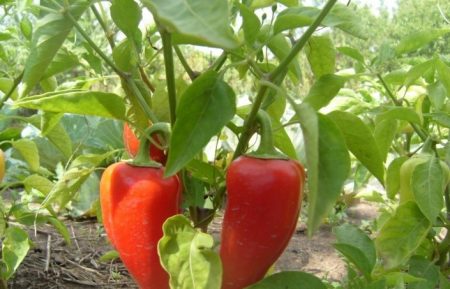
Paprika A gift from Moldova belongs to the varieties of medium ripening period - the crop can be harvested already 135-140 days after the appearance of the first shoots. Neat and compact bushes about 50 cm high do not require frequent care and are quite unpretentious. You can grow a variety in the beds and in greenhouses, in any climatic conditions and on different soil. Paprika is characterized by high immunity to common diseases, as well as endurance to variable and unstable weather conditions.
Small fruits of red color have a conical shape and average weight of 70 - 90 g, wall thickness reaches 6 mm. The pulp is unusually sweet, juicy and aromatic.
Despite the small weight of the fruits, the Gift of Moldova gives a wonderful harvest - up to 7 kg per square meter.
Lumina
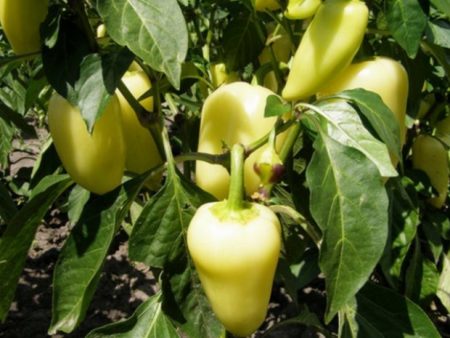
Another of the most common mid-season varieties of paprika - 130 days elapse from seedling emergence to harvest. Suitable for growing, both in the open ground and under shelter. The variety has excellent immunity to diseases even in the most adverse climatic conditions.
The compact compact bush reaches a height of about 80 cm. The ripened fruits have a red color, conical shape and an average weight of 80 - 110 g. The wall thickness is 7 mm. The taste of paprika is saturated pepper, without bitterness, the pulp is extremely juicy. The variety is characterized by excellent keeping quality, is stored for a long time and easily tolerates transportation without losing a presentable appearance. From one square meter, you can collect up to 8 kg of aromatic fruits.
Korenovsky
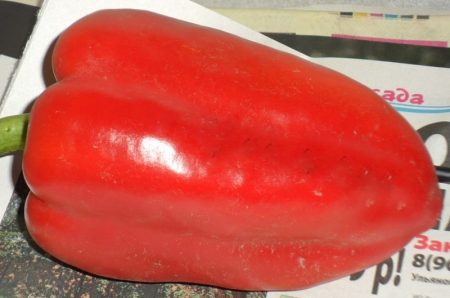
Korenovsky is a mid-season variety of paprika: 4 months pass from sprouts to the appearance of a ripe crop. It can be grown in protected and unprotected soil. The variety is characterized by high immunity to common diseases, endurance to adverse weather conditions and other negative factors.
A sprawling bush grows a little over half a meter and has large leaves. Ripe fruits have the shape of a prism or a truncated cone and a saturated red color. Peppers grow quite large - their weight reaches 200 g, and the wall thickness is 6 mm. The surface of the fruit has a wavy or ribbed structure and a dense shiny skin. The pulp of the fruit is very sweet, juicy with a rich pepper aroma. From a square meter, you can collect up to 5 kg of ripe peppers.
Bell
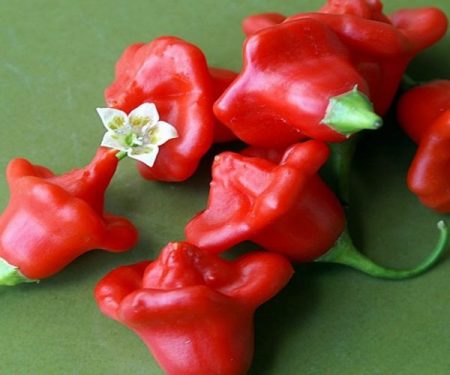
A very beautiful and unusual late-ripening variety - from the appearance of seedlings to harvesting takes an average of 15 days. The bush is very high, can reach 2 meters and requires garters to the support. Pepper is resistant to many diseases, easily tolerates temperature extremes and adverse weather factors.
The variety is characterized by an unusual shape of the fruit in the form of a red bell. The average weight of the fruit is 50-100 g, the pulp of the fruit is very juicy and aromatic with a delicate sweet and sour taste. Productivity is about 2.5 kg per square meter.
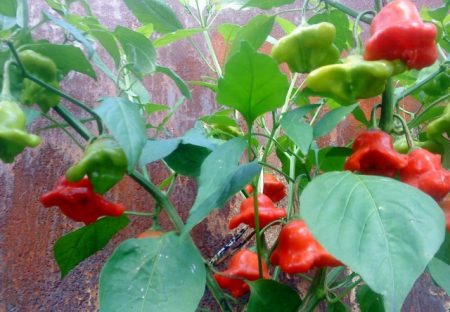
Reviews
Judging by the feedback of gardeners with experience, all of the above varieties with undemanding care give excellent yields of pepper. Variety Korenovsky can be eaten even in unripe form, and the bell perfectly tolerates frost and can serve as an additional decor for a personal plot. The Moldovan Gift always pleases with wonderful fruits - with minimal care, it practically does not get sick.




 Calorie pepper stuffed with meat and rice - BZHU per 100 grams
Calorie pepper stuffed with meat and rice - BZHU per 100 grams Gorky pepper - the best varieties for open ground
Gorky pepper - the best varieties for open ground Hot pepper seeds - the best varieties for open ground and reviews
Hot pepper seeds - the best varieties for open ground and reviews Capsicum tincture for hair - how to use and reviews
Capsicum tincture for hair - how to use and reviews